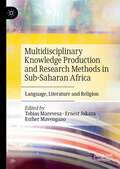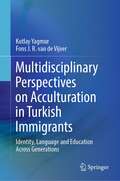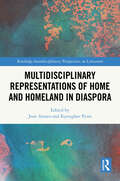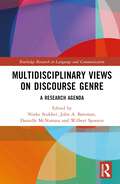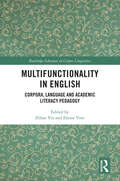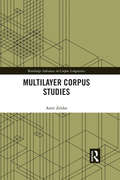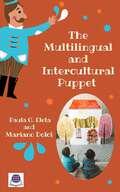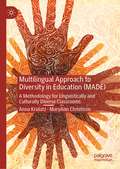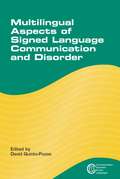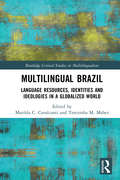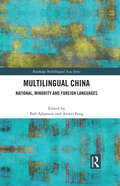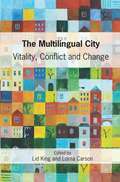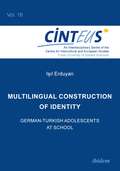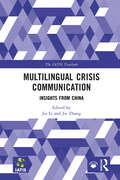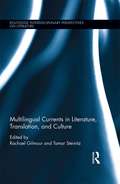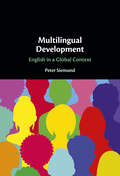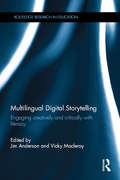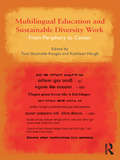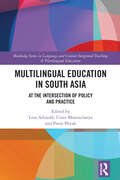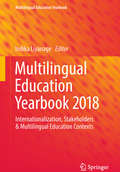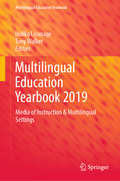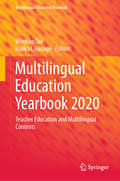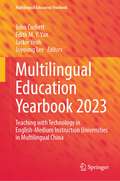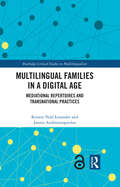- Table View
- List View
Multidisciplinary Knowledge Production and Research Methods in Sub-Saharan Africa: Language, Literature and Religion
by Tobias Marevesa Ernest Jakaza Esther MavenganoThis book, Multidisciplinary Knowledge Production and Research Methods in Sub-Saharan Africa: Language, Literature and Religion, contributes to the polemical conversations about existing architectures of knowledge and research practices in postcolonial sub-Saharan Africa. It creates an academic platform for multi-interdisciplinary research that brings to the fore inspiring efforts to break away from long-standing disciplinary bordering thinking and practices in modern-day sub-Saharan Africa. This distinctive edited collection is a valuable resource for scholars, researchers and students of multi-interdisciplinary research across the globe. The volume also promotes wide-ranging research focused on how to address complexities which hamper the promise of multi-interdisciplinary research in contemporary sub-Saharan African contexts. It provides thought-provoking perspectives on academic conversations about the uniqueness of embracing multidisciplinary research. The traditional methods of interpretation are challenged by the radical emerging demand to shift from a mono-disciplinary thinking to a cross-disciplinary epistemic endeavour in order to successfully address unfolding problematic realities that demand the pursuit of novel heuristic terrains.
Multidisciplinary Perspectives on Acculturation in Turkish Immigrants: Identity, Language and Education Across Generations
by Kutlay Yagmur Fons J. van de VijverThis book puts forward a new model of acculturation combining psychological, sociolinguistic and identity theories to study Turkish immigrants across the globe. The authors argue that such a multidisciplinary perspective is very important in understanding acculturation processes in migrants, particularly for pivotal aspects such as language and identity. Studying one group or several groups within a country is the most common methodological approach in acculturation studies. The authors argue on the basis of their extensive ethnographic work that focusing on one immigrant ethnic group across countries instead provides deeper insights into interactive acculturation orientations of both the receiving societies and immigrant groups. They therefore synthesize findings from their work on Turkish immigrants in Australia and several countries in Europe. Moreover, they include extensive accounts of acculturation across several generations of Turkish migrants, thereby giving readers insights into the long-term acculturation process. The book critically discusses language maintenance and shift, child-rearing practices and socialization beliefs, and educational achievement in Turkish immigrants, and uses a mixed-methods approach. It is meant for researchers and policy makers interested in acculturation and the role of the acculturation context.In a nutshell, the book stresses the dynamic and ever-evolving nature of linguistic habits and cultural integration tendencies and convinces the reader about the complexity of the background factors that play a role in shaping the behaviour of immigrant minorities. Anyone who reads the book will be equipped with the skills to critically assess research on immigrant language maintenance.
Multidisciplinary Representations of Home and Homeland in Diaspora (Routledge Interdisciplinary Perspectives on Literature)
by Jean Amato Kyunghee PyunThis collection explores our fascination with homes across time, cultures, and disciplines while unpacking the relationship between private yearning and public belonging, illustrating the limitations and fluidity of identity and affiliation through the idea of homes and ancestral homelands.While rooted in comparative literature and critical art history in the context of diaspora studies, the book’s approach intersects with cultural geography, gender and sexuality studies, critical race theory, architecture, urban studies, film studies, nationalism, postcolonial theory, sociology, and migration studies. Conceived as relational and changing, the collection emphasizes that home/homeland studies are plural and fluctuating concepts encompassing multi-local affiliations, places, gender roles, languages, practices, relations, and power.In this tangled site of contesting national discourses, affiliations, nostalgias, and ideologies, we can uncover valuable insight into how we construct the story of ourselves through traveling bodies, spaces, homes, and mixed geographies.
Multidisciplinary Views on Discourse Genre: A Research Agenda (Routledge Research in Language and Communication)
by Ninke Stukker John A. Bateman Danielle McNamara Wilbert SpoorenThis collection sets out an innovative research agenda for advancing a multidisciplinary approach to genre, bringing together researchers from a variety of disciplines to enhance our existing understanding of the challenges and opportunities for current and future genre research.The volume brings together perspectives from across disciplinary borders, including such fields as discourse studies, cognitive studies, computational discourse analysis, and education, to advance genre research into new directions, as it has historically been studied from a mono-disciplinary perspective. The book highlights how fruitful a multidisciplinary approach can be in accounting for the dynamic complexity of the discourse genres that underpin daily life, exploring six broad themes: defining genre; stability and variation; genre and cognition; computational methods; language and literacy development; and genre education. Taken together, the volume makes the case for the value of such an approach in better accounting for the conceptual and empirical complexities of genre and, in turn, serving as a springboard for innovations in genre research.This book will be of interest to students and scholars in linguistics, discourse studies, discourse psychology, media studies, language and literacy development, and education.
Multifunctionality in English: Corpora, Language and Academic Literacy Pedagogy (Routledge Advances in Corpus Linguistics)
by Zihan Yin and Elaine VineThis edited volume provides detailed analyses of multifunctional forms in English and offers hands-on approaches exemplifying relevant implications and useful applications to language and literacy educators in TESOL, ESL/EFL/EAL and research students in applied linguistics and education. The chapters cover: the multifunctionality of utterances in spoken and multimodal corpora, the multifunctionality of linguistic creativity in different genres, multifunctional pronouns in hard and soft sciences, and professional discourse in the university and secondary school contexts. The volume also offers a comparison of the multifunctionality of verbs between ESL textbooks, native written and spoken English corpora, and between ESL and L1 university students in writing a particular genre; comparisons of the multifunctionality of discourse markers between different registers and between L1 and L2 English speakers, as well as multifunctional metadiscourse markers in different disciplines and paradigms. With detailed analysis of authentic corpus data representing different varieties of English, specialised use in different contexts and disciplines and practical teaching and learning applications, the volume bridges theory and practice, providing a creatively designed resource for students, educators and researchers looking to understand multifunctional forms in English.
Multilayer Corpus Studies (Routledge Advances in Corpus Linguistics)
by Amir ZeldesThis volume explores the opportunities afforded by the construction and evaluation of multilayer corpora, an emerging methodology within corpus linguistics that brings about multiple independent parallel analyses of the same linguistic phenomena, and how the interplay of these concurrent analyses can help to push the field into new frontiers. The first part of the book surveys the theoretical and methodological underpinnings of multilayer corpus work, including an exploration of various technical and data collection issues. The second part builds on the groundwork of the first half to show multilayer corpora applied to different subfields of linguistic study, including information structure research, referentiality, discourse models, and functional theories of discourse analysis, synthesizing these different discussions in a detailed case study of non-standard language in its concluding chapter. Advancing the multilayer corpus linguistic research paradigm into new and different directions, this volume is an indispensable resource for graduate students and researchers in corpus linguistics, syntax, semantics, construction studies, and cognitive grammar.
The Multilingual and Intercultural Puppet: An Innovative Approach to Learning Foreign and Second Langauges
by Paula G. Eleta Mariano DolciAs the world becomes increasingly more interconnected and globalized, increasingly more families are seeking early (0-6 years) foreign and second language education, prompting educators and teachers to seek out age-appropriate tools which offer an innovative approach to early language learning (ELL). The Multilingual and Intercultural Puppet tries to answer two questions: How can we introduce children to foreign languages at an early age in a natural and also naturally playful way? And with which approach? This book presents a documented reflection that is rooted in concrete experiences which the authors have accumulated over the past twenty years of field-work, providing readers with many innovative yet practical and operational examples of how puppets have been used to facilitate ELL. Puppets, easily integrated into chilren’s natural play environment, represent a pedagogical tool par excellence for the teaching-learning of foreign languages. Using puppets, educators can create stimulating and enriching learning contexts, engaging children and moving them towards educational learning objectives, very naturally and through active and interactive play. Moreover, puppets, being puppets, can speak various languages, experience various life-events, and share these with young learners, be they homogeneous, heterogeneous, international, transcultural and/or intercultural groups. Indeed, “the language of puppets” is naturally multilingual and intercultural.
Multilingual Approach to Diversity in Education (MADE): A Methodology for Linguistically and Culturally Diverse Classrooms
by Anna Krulatz MaryAnn ChristisonThis book introduces the Multilingual Approach to Diversity in Education (MADE), a framework that provides an extensive, holistic instrument with research-based teacher indicators for teachers, teacher educators, and administrators to deliver optimal education to multilingual learners in a range of contexts. The authors introduce and provide a theoretical and research-based rationale for the MADE, presenting in turn each of its seven indicators, situating them within current research and theory in multilingualism and education, and providing specific examples of classroom applications. This book will be of interest to academics, teacher educators, pre-service and practicing teachers, and graduate students interested in teaching and researching multilingual learners.
Multilingual Aspects of Signed Language Communication and Disorder
by David Quinto-PozosInquiry into signed languages has added to what is known about structural variation and language, language learning, and cognitive processing of language. However, comparatively little research has focused on communication disorders in signed language users. For some deaf children, atypicality is viewed as a phase that they will outgrow, and this results in late identification of linguistic or cognitive deficits that might have been addressed earlier. This volume takes a step towards describing different types of atypicality in language communicated in the signed modality such as linguistic impairment caused by deficits in visual processing, difficulties with motor movements, and neurological decline. Chapters within the book also consider communication differences in hearing children acquiring signed and spoken languages.
Multilingual Brazil: Language Resources, Identities and Ideologies in a Globalized World (Routledge Critical Studies in Multilingualism)
by Marilda C. Cavalcanti Terezinha M. MaherThis book brings together cutting edge work by Brazilian researchers on multilingualism in Brazil for an English-speaking readership in one comprehensive volume. Divided into five sections, each with its own introduction, tying together the themes of the book, the volume charts a course for a new sociolinguistics of multilingualism, challenging long-held perceptions about a monolingual Brazil by exploring the different policies, language resources, ideologies and social identities that have emerged in the country’s contemporary multilingual landscape. The book elucidates the country’s linguistic history to demonstrate its evolution to its present state, a country shaped by political, economic, and cultural forces both locally and globally, and explores different facets of today’s multilingual Brazil, including youth on the margins and their cultural and linguistic practices; the educational challenges of socially marginalized groups; and minority groups’ efforts to strengthen languages of identity and belonging. In addition to assembling linguistic research done in Brazil previously little known to an English-speaking readership, the book incorporates theoretical frameworks from other disciplines to provide a comprehensive picture of the social, political, and cultural dynamics at play in multilingual Brazil. This volume is key reading for researchers in linguistic anthropology, sociolinguistics, applied linguistics, cultural studies, and Latin American studies.
Multilingual China: National, Minority and Foreign Languages (Routledge Multilingual Asia Series #12)
by Bob AdamsonMultilingual China explores the dynamics of multilingualism in one of the most multilingual countries in the world. This edited collection comprises frontline empirical research into a range of important issues that arise from the presence of 55 official ethnic minority groups, plus China’s search to modernize and strengthen the nation’s place in the world order. Topics focus on the dynamics of national, ethnic minority and foreign languages in use, policy making and education, inside China and beyond. Micro-studies of language contact and variation are included, as are chapters dealing with multilingual media and linguistic landscapes. The book highlights tensions such as threats to the sustainability of weak languages and dialects, the role and status of foreign languages (especially English) and how Chinese can be presented as a viable regional or international language. Multilingual China will appeal to academics and researchers working in multilingualism and multilingual education, as well as sinologists keen to examine the interplay of languages in this complex multilingual context.
The Multilingual City
by Lid King Lorna CarsonThis book is an exploration of the vitality of multilingualism and of its critical importance in and for contemporary cities. It examines how the city has emerged as a key driver of the multilingual future, a concentration of different, changing cultures which somehow manage to create a new identity. The book uses the recent LUCIDE multilingual city reports as a basis for discussion and analysis, and deals with both societal and individual multilingualism in a way that draws on the full range of their historical, contemporary, visual/audible, psychological, educational and policy-oriented aspects. The book will be of interest to students and researchers of multilingualism, migration studies, European Studies, anthropology, sociology and urbanism.
Multilingual Construction of Identity: German-Turkish Adolescents at School (Cinteus Ser. #16)
by Isil ErduyanReporting on a linguistic ethnographic study, Işıl Erduyan explores multilingual identity construction of high school students of Turkish descent enrolled in a downtown high school (Gymnasium) in Berlin. She focuses on naturally occurring classroom interactions across German, Turkish, and English classes and attends to the complex relationship between identities and multilingual repertoires through a scalar analytical perspective. Her findings demonstrate how multilingual students’ linguistic repertoires are bound by linguistic performances within and across multiple timescales. The study takes an innovative path by attending to the everyday linguistic practices of a group of multilingual immigrant students with the same national background through linguistic ethnographic lenses in the context of mainstream schooling in Europe, and by focusing on a much-understudied group, namely higher achieving students of immigrant descent enrolled in a German high school.
Multilingual Crisis Communication: Insights from China (The IATIS Yearbook)
by Jia Li Jie ZhangMultilingual Crisis Communication is the first book to explore the lived experiences of linguistic minorities in crisis-affected settings in the Global South, particularly during the Covid-19 pandemic. China has been selected as a case of inquiry for multilingual crisis communication because of its high level of linguistic diversity. Taking up critical sociopolitical approaches, this book conceptualizes multilingual crisis communication from three dimensions: identifying communication barriers, engaging communication repertoires, and empowering communication justice.Comprising eight main chapters, along with an introduction and an epilogue, this edited book is divided into three parts in terms of the demographic and social conditions of linguistic minorities, as indigenous, migrant, and those with communicative disabilities. This book brings together a range of critical perspectives of sociolinguistic scholars, language teachers, and public health workers. Each team of authors includes at least one member of the research community with many years of field work experience, and some of them belong to ethnic minorities. These studies can generate new insights for enhancing the accessibility and effectiveness of multilingual crisis communication.This book will be of interest to academics and postgraduate students in the fields of multilingualism, intercultural communication, translation and interpreting studies, and public health policy.
Multilingual Currents in Literature, Translation and Culture (Routledge Interdisciplinary Perspectives on Literature)
by Rachael Gilmour Tamar SteinitzAt a time increasingly dominated by globalization, migration, and the clash between supranational and ultranational ideologies, the relationship between language and borders has become more complicated and, in many ways, more consequential than ever. This book shows how concepts of ‘language’ and ‘multilingualism’ look different when viewed from Belize, Lagos, or London, and asks how ideas about literature and literary form must be remade in a contemporary cultural marketplace that is both linguistically diverse and interconnected, even as it remains profoundly unequal. Bringing together scholars from the fields of literary studies, applied linguistics, publishing, and translation studies, the volume investigates how multilingual realities shape not only the practice of writing but also modes of literary and cultural production. Chapters explore examples of literary multilingualism and their relationship to the institutions of publishing, translation, and canon-formation. They consider how literature can be read in relation to other multilingual and translational forms of contemporary cultural circulation and what new interpretative strategies such developments demand. In tracing the multilingual currents running across a globalized world, this book will appeal to the growing international readership at the intersections of comparative literature, world literature, postcolonial studies, literary theory and criticism, and translation studies.
Multilingual Development: English in a Global Context
by Peter SiemundEnglish as a global lingua franca interacts with other languages across a wide range of multilingual contexts. Combining insights from linguistics, education studies, and psychology, this book addresses the role of English within the current linguistic dynamics of globalization. It takes Singapore, Hong Kong, and Dubai as case studies to illustrate the use of English in different multilingual urban areas, arguing that these are places where competing historical assessments, and ideological conceptions of monolingualism and multilingualism, are being acted out most forcefully. It critically appraises the controversial concept of multilingual advantages, and studies multilingual cross-linguistic influence in relation to learning English in bilingual heritage contexts. It also scrutinises multilingual language policies in their impact on attitudes, identities, and investment into languages. Engaging and accessible, it is essential reading for academic researchers and advanced students of bi- and multilingualism, globalization, linguistic diversity, World Englishes, sociolinguistics, and second/third language acquisition.
Multilingual Digital Storytelling: Engaging creatively and critically with literacy (Routledge Research in Education)
by Jim Anderson Vicky MacleroyClassrooms are increasingly multicultural in their social composition, and students are increasingly connected, through digital media, to local and global networks. However, pedagogy has failed to take full advantage of the opportunities these resources represent. Multilingual Digital Storytelling draws attention to the interfaces between learner engagement, creativity and critical digital literacy, as well as addressing the multilingual within the multiliteracies framework. Addressing a significant gap in the field of multiliteracies by focusing on multilingualism, this book explores new digital spaces for language learning and methods of extending understandings of youth literacy in an increasingly interconnected world. Drawing on innovative and multi-site research projects based in mainstream and community schools in London and overseas, this book discusses how young people become engaged creatively and critically with literacy by demonstrating how digital storytelling can be used as a tool for language development. The book begins by considering linguistic, cultural, cognitive and social dimensions of language learning from a theoretical perspective, whilst the second part focuses on practical case studies that reflect and illustrate these theoretical principles. Offering a powerful new perspective on multiliteracies pedagogy, Multilingual Digital Storytelling will appeal to researchers and academics in the fields of education, applied linguistics, sociology and youth and community studies. It will also be an invaluable resource for teachers, teacher educators, curriculum planners and policymakers.
Multilingual Education and Sustainable Diversity Work: From Periphery to Center
by Tove Skutnabb-Kangas Kathleen HeughThis very original, inspirational book globalises our understanding of languages in education and changes our understanding of bilingual and multilingual education from something mostly western to being truly transnational: it spotlights the small, celebrates African and Asian cases of multilingual classrooms and demonstrates that such education is universally successful. Colin R. Baker, Pro Vice-Chancellor, Bangor University, Bangor, Wales, UK A norm-setting work on multilingual education, which combines theoretical perspectives with practical experience from different parts of the globe, this book demonstrates convincingly not only that multilingual education works, but also that, for most developing countries, there is no viable alternative. Ayo Bamgbose, Professor Emeritus, University of Ibadan, Nigeria This excellent volume brings to light the fascinating lived experiences of multilingual education in linguistically rich but resource impoverished countries, and offers important lessons from which we can all learn. Amy B. M. Tsui, Professor , Pro Vice-Chancellor & Vice President, The University of Hong Kong, Hong Kong This is a book of hope and inspiration. Documenting the significant shift that is taking place in countries around the world in the status and legitimacy of mother tongue-based multilingual education, it represents a giant step towards a "tipping point" where mother tongue-based multilingual education will be normalized as the preferred and, in fact, common sense option for educating the children of the world. Jim Cummins, The University of Toronto, Canada This important book challenges us to think about multilingual education from a different angle––this time putting the periphery at the center. The effect is one of destabilizing old visions and imagining new worlds where multilingual education provides the backdrop for generous understandings of all peoples. Ofelia García, Program in Urban Education, Graduate Center/The City University of New York, USA There are regrettably few detailed accounts of successful elementary school instruction in the pupils' home language, which makes this book with its surprising examples (especially Ethiopia and Nepal but other third world cases) so relevant. Students of language education policy will learn a great deal about the possibility of multilingual education from the chapters of this important book. Bernard Spolsky, Professor Emeritus, Bar-Ilan University, Israel At least half of today’s languages are marginalised and endangered and the attention of the world needs to be focused on these minor and minority languages together with the value of multilingualism. If the book succeeds in enhancing the consciousness of the world towards predicaments of the third world, then its efforts will have been amply rewarded. Debi Prasanna Pattanayak, Former Director, Central Institute of Indian Languages, India Drawing on the most powerful and compelling research data to date and connecting this research to linguistic human rights, this book explores the conditions and practices of robust bilingual and multilingual educational innovations in both system-wide and minority-settings and what it is that makes these viable. It demonstrates how, in countries where educational practices are inclusive of linguistic diversity and responsive to local conditions and community participation, implementation of bilingual education even within limited budgetary investment can be successful.
Multilingual Education in South Asia: At the Intersection of Policy and Practice (Routledge Series in Language and Content Integrated Teaching & Plurilingual Education)
by Lina Adinolfi Usree Bhattacharya Prem PhyakSpanning scholarly contributions from India, Nepal, Bangladesh, Pakistan, and Sri Lanka, this edited volume seeks to capture and elucidate the distinct challenges, approaches and possible solutions associated with interpreting, adapting and applying language-in-education policies in a range of linguistically complex teaching and learning environments across South Asia. Centring on-the-ground perspectives of scholars, practitioners, pupils, parents and the larger community, the volume offers new insights into one of the most complex, populous, and diverse multilingual educational contexts in the world. Language-in-education policies and practices within this setting represent particularly high stakes issues, playing a pivotal role in determining access to literacy, thereby forming a critical pivot in the reproduction of educational inequality. The broad aim of the collection is thus to highlight the pedagogical, practical, ideological and identity-related implications arising from current language-in-education policies in this region, with the aim of illustrating how systemic inequality is intertwined with such policies and their associated interpretations. Aimed at both academics and practitioners - whether researchers and students in the fields of education, linguistics, sociology, anthropology or South Asian studies, on the one hand, or language policy advisors, curriculum developers, teacher educators, teachers, and members of funding bodies, aid providers or NGOs, on the other - it is anticipated that the accounts in this volume will offer their readership opportunities to consider their wider implications and applications across other rich multilingual settings – be these local, regional, national or global.
Multilingual Education Yearbook 2018: Internationalization, Stakeholders And Multilingual Education Contexts (Multilingual Education Yearbook Ser.)
by Indika LiyanageThis volume examines how internationalization, stakeholders, and educational contexts have a reciprocal influence on multilinguals and their communities both as individual and collective variables. Therefore, the exploration of these variables and how they intersect and interact with worldwide phenomena like globalization, global citizenship, and responsive and responsible provisions of education are the central foci of this volume. Contributors from different parts of the world draw on analyses of various forms of data to foreground these foci with implications for effective multilingual education practices in their contexts, and beyond.The Multilingual Education Yearbook publishes high-quality empirical research on education in multilingual societies. It publishes research findings that, in addition to providing descriptions of language learning, development and use in language contact and multilingual contexts, will shape language education policy and practices in multilingual societies.
Multilingual Education Yearbook 2019: Media of Instruction & Multilingual Settings (Multilingual Education Yearbook)
by Indika Liyanage Tony WalkerThis book offers essential insights into the challenges and complexities surrounding the medium of instruction (MOI), its impact on all languages and stakeholders in multilingual contexts, educational processes, developments and outcomes. MOI has been a prominent topic in recent debates on the role of languages in education in multilingual contexts, partly because prioritizing one language over others as the medium of instruction has a profound impact on all languages and stakeholders in multilingual contexts. These include, to name but a few, (language) teachers, teacher educators, students, and policymakers, as well as industries and enterprises built around the needs and expectations of these stakeholders. This book presents high-quality empirical research on education in multilingual societies. It highlights research findings that, in addition to providing descriptions of language learning, development and use in language contact and multilingual contexts, will help shape future language education policy and practices in multilingual societies.
Multilingual Education Yearbook 2020: Teacher Education and Multilingual Contexts (Multilingual Education Yearbook)
by Indika Liyanage Wenhao TaoThis book focuses on the challenges of teaching in diversely multilingual classrooms, discussing how these challenges and complexities interact in the preparation of teachers (language & content areas) in and for multilingual settings, and how they impact on educational processes, developments, and outcomes.Teacher education in multilingual contexts is a key topic and occupies an important position in efforts to improve educational outcomes and quality for all stakeholders. It is seen as essential for competitive participation in global economic activity and for providing opportunities to enjoy the benefits of increased prosperity. Teacher education is generally expected to address both the demand for multilingualism and the challenges of teaching in diversely multilingual classrooms, which are important foci at policy and institutional levels. For example, the demand for quality outcomes is manifested in state-administered standards and performance cultures that regulate entry and practices, and poses ethical and pedagogic dilemmas for teachers. This book presents high-quality empirical research on education in multilingual societies, highlighting findings that, in addition to providing descriptions of language learning, development, and use in language contact and multilingual contexts, will help shape future language education policy and practices in multilingual societies.
Multilingual Education Yearbook 2021: Policy and Practice in STEM Multilingual Contexts (Multilingual Education Yearbook)
by Anthony A. Essien Audrey MsimangaThis edited book attempts to foreground how challenges and complexities between policy and practice intertwine in the teaching and learning of the STEM subjects in multilingual settings, and how they (policy and practice) impact on educational processes, developments and outcomes. The unique feature of this book, thus, lies in its combination of not just language issues in the teaching and learning of the STEM subjects, but also in how these issues relate to policy and practice in multilingual contexts and how STEM research and practice may inform and shape language policies and their implementation in multilingual contexts. This book is of interest to stakeholders involved in STEM education such as researchers, undergraduate and graduate students, tertiary level teachers, teacher educators, curriculum developers as well as other professionals with responsibilities in STEM education subjects. The book is written in a way that is accessible to a wide range of backgrounds, including those who are in language education.
Multilingual Education Yearbook 2023: Teaching with Technology in English-Medium Instruction Universities in Multilingual China (Multilingual Education Yearbook)
by John Corbett Edith M. Y. Yan Jackie Yeoh Juyoung LeeThis book provides a wealth of insights into the use of technology to deliver university courses with English as the medium of instruction (EMI). It presents practical case studies from a number of Chinese HE institutions that offer degree programmes in English. The cases illustrate the benefits to be gained from collaborative action research among English language educators and subject specialists in the Sciences, Social Sciences, Humanities, Business and Management. The chapters address students’ and instructors’ engagements with established technologies, such as the Moodle learning management system, and with more recent innovations, such as mobile learning, social media use in the classroom, and game-based learning. Topics range from curriculum design that attends to the use of technology in the delivery of courses through EMI, and the benefits of technology in supporting pedagogical innovations such as online peer assessment, to the use of specific apps to enhance students’ comprehension of course materials. The book will be of vital interest to curriculum planners and designers, as well as to instructors in higher education who are engaged in delivering courses using English as a medium of instruction.
Multilingual Families in a Digital Age: Mediational Repertoires and Transnational Practices (Routledge Critical Studies in Multilingualism)
by Kristin Vold Lexander Jannis AndroutsopoulosThis book offers new insights into transnational family life in today’s digital age, exploring the media resources and language practices parents and children employ toward maintaining social relationships in digital interactions and constructing transnational family bonds and identities. The book seeks to expand the boundaries of existing research on family multilingualism, in which digital communication has been little studied until now. Drawing on ethnographic studies of four families of Senegalese background in Norway, Lexander and Androutsopoulos develop an integrated approach which weaves together participants’ linguistic choices for situated interaction, the affordances of digital technologies, and the families’ language and media ideologies. The book explores such key themes as the integration of linguistic and media resources in family repertoires, creative practices of digital translanguaging, engagement in diaspora practices, and opportunities of digital communication for the development of children's heritage language skills. With an innovative perspective on ‘doing family’ in the digital age, this book will be of interest to students and scholars in multilingualism, sociolinguistics, digital communication, language and communication, and language and media.
